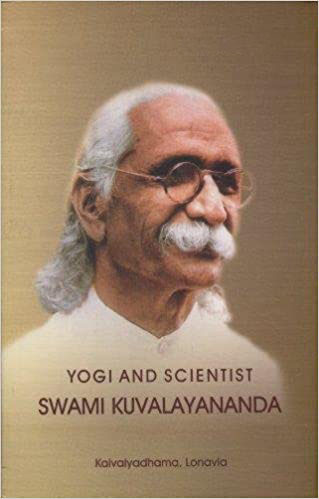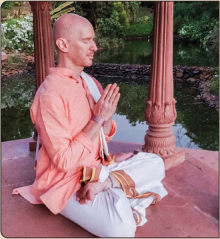 The practice of Yoga and the science of Yoga, or Yogabhyasa and Yogavidya, are two of the traditional ways that Yoga is described. Yoga is a practice (abhyasa) and a science (vidya). While asanas and pranayama are immensely popular and currently the most visible expressions of the practice of Yoga, the science of Yoga has a deep and ancient history, though it has not enjoyed the same recent popularity on a public scale as postures have. There is a distinction that needs to be made between the Western definition of science and the Sanskrit word vidya, which means both science and knowledge.
The practice of Yoga and the science of Yoga, or Yogabhyasa and Yogavidya, are two of the traditional ways that Yoga is described. Yoga is a practice (abhyasa) and a science (vidya). While asanas and pranayama are immensely popular and currently the most visible expressions of the practice of Yoga, the science of Yoga has a deep and ancient history, though it has not enjoyed the same recent popularity on a public scale as postures have. There is a distinction that needs to be made between the Western definition of science and the Sanskrit word vidya, which means both science and knowledge.
While both the Sanskritic and Western translations of science incorporate knowledge, understanding, investigation and quantification, the West regards science as examining observable phenomena that can be verified through measurement and data collection, while the Hindu and yogic sciences accept one’s inner experience as a valid source of data collection (pratyaksha). The inner experience is, in fact, the primary source of knowledge, while anything that is observed, heard or inferred is secondary (Yoga Sutra, 1.7). As well, the inner source of knowledge may be an immeasurable, something the West does not factor into science. It’s hard to measure something that, by definition, is immeasurable.
I had heard from my teachers in India for many years that Yoga is a process of internal revelation, the Self revealing itself in the conscious awareness of the seeker. Liberation, and even wisdom, are not something to be added to you from the outside, but revealed from the inside. So, to busy oneself collecting data and amassing information, while useful for sharpening the intellect, is not as useful for inner growth. This idea led me to focus on internal practices for the better part of two decades—that is until Western science came knocking on my door and I answered.
A scientist named Dr. Marshall Hagins, having been referred to me by a student, wanted to know if I could create a Yoga protocol for a study focused on treating hypertension. His hypothesis was that the practices of asanas and pranayama would have a down-regulating effect on hypertension through the actions on the vagus nerve. My interest was piqued.
 Swami Kuvalyananda (1883–1966) was the first Indian to study Yoga using Western scientific methodologies in an effort to find a meeting place of the two doctrines. Though both are of immense value as stand-alone disciplines, he felt they could help each other progress in an increasingly modern society. He knew that Western science was not necessary to prove that Yoga worked—Yoga had already been proven to work, as its practices had been perpetuated for several millennia in India already. But by using Western science to examine the efficacies of Yoga, there could be discoveries of side benefits, and that could encourage those who might benefit from it to take up its practice, both in India and abroad. He famously said, “Persons that are equipped with an undying faith in spiritual culture and its attainment through yogic practices require no scientific interpretations of these for their progress. But those that take their stand upon reason would be satisfied with nothing short of a scientific explanation of Yoga, if they are to be induced to take to it.” (Psycho-physiology, Spiritual and Physical Culture, etc., with their application to Therapeutics, Kuvalayananda S., Yoga Mimamsa 1:79-80, 1924.)
Swami Kuvalyananda (1883–1966) was the first Indian to study Yoga using Western scientific methodologies in an effort to find a meeting place of the two doctrines. Though both are of immense value as stand-alone disciplines, he felt they could help each other progress in an increasingly modern society. He knew that Western science was not necessary to prove that Yoga worked—Yoga had already been proven to work, as its practices had been perpetuated for several millennia in India already. But by using Western science to examine the efficacies of Yoga, there could be discoveries of side benefits, and that could encourage those who might benefit from it to take up its practice, both in India and abroad. He famously said, “Persons that are equipped with an undying faith in spiritual culture and its attainment through yogic practices require no scientific interpretations of these for their progress. But those that take their stand upon reason would be satisfied with nothing short of a scientific explanation of Yoga, if they are to be induced to take to it.” (Psycho-physiology, Spiritual and Physical Culture, etc., with their application to Therapeutics, Kuvalayananda S., Yoga Mimamsa 1:79-80, 1924.)
One could make the case that much of what we think of as scientific thought is making a supposition and then using research, experimentation, examination and more suppositions to eventually reach repeatable and dependable conclusions. Those conclusions often lead to more discoveries that expand a particular field of focus. The framework of Yogavidya follows this same trajectory, while making up a dialogue of Yoga that has been occurring now for thousands of years. Much of what is referenced in Yoga teachings today is from the writings of Bhagavan Patanjali, the author of the Yoga Sutras (400ce), an unparalleled collection of aphorisms that define the essence of Yoga.
In the first few sutras, Patanjali makes it abundantly clear that Yoga is a practice for quieting and eliminating the extraneous activities of the mind to lead us away from states of limited self-awareness. Yoga is the process of eliminating discursive thought so the mind can be directed towards one object of attention, and the process of thinning or removing the seed impressions from which our thoughts arise. These impressions are called samskaras—memories and subtle impressions in the subconscious mind.
When these two processes—of focused awareness and removal of impressions—reach their pinnacle, our awareness shifts from identifying with thoughts and the myriad of subtleties of feelings, emotions, memories and shifting identities, and reverts to its original identity of ultimate awareness of the Self alone, abiding then in its original, pristine freedom. The methodology of achieving this is strategic and described as a step-by-step process. To follow that process is to engage in the endeavor of Yogabhyasa which is based on the instructions, anushasanam, explained through the Yogavidya.
Oddly, we see little of this deeper understanding in the field of Yoga today. Asanas and pranayama are the most visible and popular practices in India and in the West. Nowadays when people say the word Yoga you can almost assume that they are talking about Yoga postures and equating the two. On the one hand, we could say that simply doing asanas is not really practicing Yoga at all—or perhaps just partially.
Sri Krishnamacharya agreed with this when he stated that the practice of Yoga begins when we realize we are suffering, and take active steps to not only remove suffering, but to understand and recognize its source. Anyone can do asanas and pranayamas, he continued, but those practices only become Yoga when they are done with the express purpose to remove suffering.
About the Author:
 Eddie Stern is a Yoga instructor and author from New York City. His latest book is One Simple Thing, A New Look at the Science of Yoga and How it Can Change Your Life, and his newest app is “Yoga365, micro-practices for an aware life.” His daily, live Yoga classes can be found on www.eddiestern.com
Eddie Stern is a Yoga instructor and author from New York City. His latest book is One Simple Thing, A New Look at the Science of Yoga and How it Can Change Your Life, and his newest app is “Yoga365, micro-practices for an aware life.” His daily, live Yoga classes can be found on www.eddiestern.com
(Reprinted from Hinduism Today)

